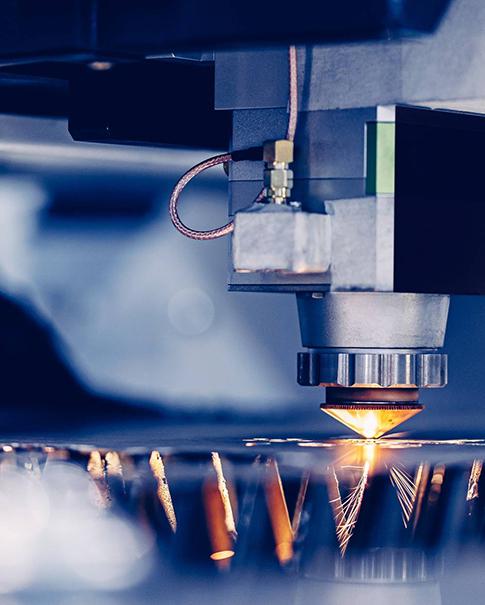CNC 표면 가공: 유형, 차트 및 테스트에 대한 포괄적인 가이드
Sep 05, 2025
표면 품질은 CNC 가공 부품의 정밀도를 측정하는 핵심 지표입니다. 표면 품질에는 거칠기(미시적 불균일성), 파형(거시적 주기적 불균일성), 그리고 질감(가공 공구 경로 방향)의 세 가지 측면이 포함됩니다.
I. 표면 처리 유형(달성 방법)
다양한 가공 작업과 전략을 통해 다양한 표면 마감을 얻을 수 있습니다. 다음은 거친 표면부터 미세 표면까지 순서대로 정리한 것입니다.
처리 유형 및 적용 가능한 시나리오에 대한 일반적으로 달성 가능한 거칠기(Ra) 설명
12.5μm~3.2μm의 황삭 가공은 깊은 절삭 깊이와 높은 이송 속도를 사용하여 소재를 빠르게 제거하므로, 눈에 띄는 공구 자국과 불량한 표면이 남습니다. 부품 초기 성형 시에는 중요하지 않은 표면에 대한 가공 여유가 유지됩니다.
준정삭은 3.2~1.6μm의 두께로 정삭을 준비하고, 거친 가공 흔적을 제거하며, 정삭에 필요한 적정 여유를 확보하기 위한 작업입니다. 대부분의 비접합면, 설치면 등의 최종 가공에 사용됩니다.
1.6μm~0.8μm의 기존 마무리는 작은 절삭 깊이, 낮은 이송 속도, 높은 회전 속도를 채택합니다. 칼날 자국은 육안으로는 보이지만 만지면 매끄럽습니다. 가장 일반적인 정밀도 요구 사항은 정적 접합면, 밀봉면, 베어링 하우징 등에 적용됩니다.
0.8μm~0.4μm의 고정밀 가공에는 최적화된 파라미터, 날카로운 절삭 공구, 고강성 공작 기계 및 효과적인 냉각이 필요합니다. 표면은 매우 매끄럽습니다. 동적 접합면, 유압 실린더 벽 및 고하중 지지면이 특징입니다.
0.4μm~0.1μm 초정밀 가공에는 단결정 다이아몬드 공구 사용, 매우 높은 공작 기계 정밀도, 그리고 안정적인 환경(항온)이 필요합니다. 광학 부품, 정밀 기기 표면, 실리콘 웨이퍼 가공 등이 여기에 해당합니다.
수동 연마/연삭 < 0.1μm: 손이나 사포, 오일스톤과 같은 기계적 수단을 사용하여 칼자국을 제거하여 거울과 같은 효과를 얻을 수 있습니다. 외관 부품, 금형 캐비티, 식품 및 의료 장비 표면.
II. 기호, 차트 및 주석(지정 방법)
엔지니어는 표면 거칠기 기호를 통해 도면에 요구 사항을 명확하게 지정합니다.
1. 기본 기호
기호 의미에 대한 설명
√ 기본 기호는 어떠한 과정을 통해서도 표면을 얻을 수 있으며, 단독으로 사용하는 것은 의미가 없음을 나타냅니다.
Youdaoplaceholder0는 재료를 제거하는 데 가장 일반적으로 사용되는 방법입니다. 밀링, 터닝, 드릴링 등의 가공 방법을 통해 재료를 제거하여 표면을 얻는다는 것을 나타냅니다.
"재료의 비제거는 주조, 단조, 압연 등을 통해 형성된 표면으로 가공이 필요하지 않은 것을 말합니다."
2. 완전한 주석(물질 기호 제거를 예로 들어):
` ` `
[a] - 거칠기 매개변수 및 값(예: Ra 0.8)
[b] - 가공 방법(예: "밀링")
[c] - 텍스처 방향 기호(예: "=")
[d] - 가공 여유(예: 0.3mm)
[e] - 샘플링 길이(예: 0.8mm)
3. 일반적인 주석 예:
· ⌝ Ra 1.6: 가장 일반적인 형태입니다. 재료를 제거하는 방법에 따른 최대 표면 거칠기 Ra 값이 1.6μm임을 나타냅니다.
· ⌝ Ra max 3.2: Ra 값은 3.2μm를 초과해서는 안 됩니다.
· ⌝ Ra 0.8 / Rz 3.2: Ra와 Rz 값이 모두 지정됩니다.
· ⌝ Rz 10 N8: "N 등급"으로 표시되어 있으며, N8은 Rz 10μm에 해당합니다.
4. 표면 질감 방향 기호: 질감 방향은 밀봉 및 동작 조정에 매우 중요합니다. 기호는 연장선에 표시됩니다.
기호 의미의 개략도
뷰에 평행한 투영 평면의 툴 경로 방향은 해당 평면의 경계와 평행합니다.
뷰의 투영 평면에 수직으로, 툴 경로의 방향은 툴 경로가 위치한 평면의 경계에 수직입니다.
X-cross 텍스처 도구 경로는 십자가 모양(예: 앞뒤로 밀링)입니다.
M 지배적인 방향이 없는 다방향(예: 포인트 밀링)
C 근사 동심원은 회전을 통해 생성됩니다.
R-근사 방사선은 단면 선삭 또는 단면 밀링을 통해 생성됩니다.
iii. 표면 거칠기 테스트(확인 방법)
가공이 완료된 후에는 전문적인 기구를 사용하여 객관적인 측정을 통해 도면의 요구 사항을 충족하는지 확인해야 합니다.
1. 접촉식 프로파일로미터(바늘 추적 방식)
· 원리: 가장 고전적이고 권위 있는 방법입니다. 매우 날카로운 다이아몬드 프로브(팁 반경 약 2μm)를 작업물 표면에 부드럽게 미끄러지듯 움직입니다. 수직 변위는 전기 신호로 변환되고, 이 신호는 증폭되어 Ra 및 Rz와 같은 매개변수를 계산합니다.
· 장비 : 표면조도 측정기.
· 장점: 정밀한 측정, 국가 표준 준수, 다양하고 복잡한 형상 측정 가능.
· 단점: 접촉식 측정이므로 매우 부드러운 소재에 흠집을 낼 수 있으며, 측정 속도가 비교적 느립니다.
2. 비접촉식 광 프로파일러
· 원리: 광 간섭, 공초점 현미경 또는 백색광 산란과 같은 기술을 사용하여 표면에 반사되는 빛을 분석하고 거칠기를 계산하여 3D 표면 지형을 구성합니다.
· 장점: 속도가 빠르고, 작업물이 긁히지 않으며, 매우 부드러운 소재도 측정할 수 있습니다.
· 단점: 표면 반사 특성에 민감함(투명하고 반사율이 높은 재료는 측정하기 어려움) 및 장비가 일반적으로 더 비쌈.
3. 샘플 블록 비교(빠르고 실용적인 방법)
· 원리: Ra 값이 알려진 표준 시료 블록 세트를 사용합니다. 손톱으로 표면을 촉각하고 시각적으로 비교하여 측정할 표면과 시료 블록을 비교하여 대략적인 거칠기 범위를 추정합니다.
· 장점: 비용이 매우 저렴하고 빠르고 편리하며 작업장 현장에 적합합니다.
· 단점: 주관성이 높고 정확도가 낮습니다. 대략적인 추정 및 예비 판단에만 사용할 수 있으며 최종 승인의 기준으로 사용할 수 없습니다.
제안된 측정 프로세스
1. 도면 분석: 측정할 매개변수(예: Ra)와 이론값을 명확하게 식별합니다.
2. 표면을 청소합니다. 테스트한 부분에 기름 얼룩, 먼지, 거친 부분이 없는지 확인합니다.
3. 선정 방법:
· 빠른 온라인 확인 → 비교 블록을 활용하세요.
· 최종 품질 검사 → 접촉식 프로파일로미터를 사용합니다.
부드럽거나 거울처럼 마감된 작업물의 경우 비접촉 광학 측정을 고려하세요.
4. 측정 수행: 결과의 대표성을 보장하기 위해 표면의 다양한 위치에서 여러 번 측정하여 평균을 구합니다.
5. 기록 및 판단: 측정값을 기록하고 도면의 요구 사항과 비교하여 합격 또는 불합격을 판단합니다.
정확한 가공 기술, 명확한 도면 표시, 과학적 측정 검증을 결합해야만 CNC 부품의 표면 품질을 완벽하게 제어할 수 있습니다.
